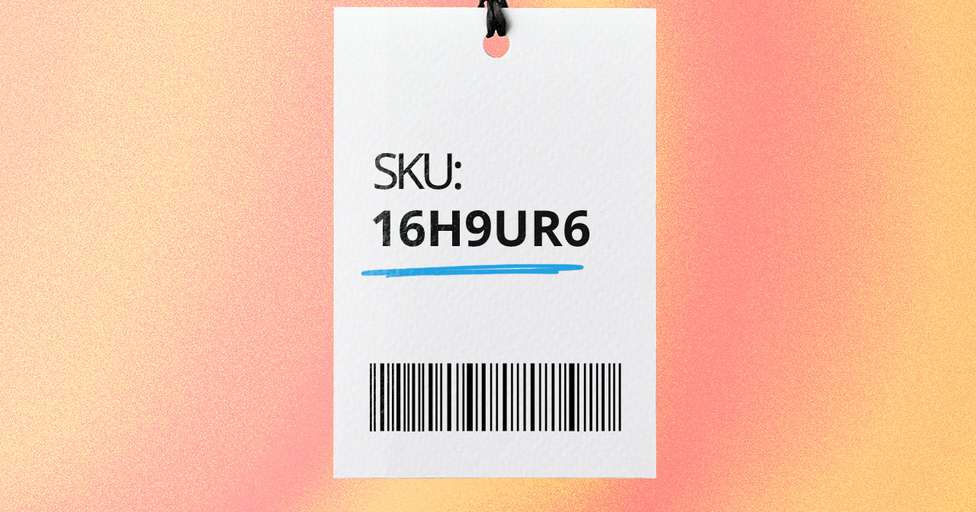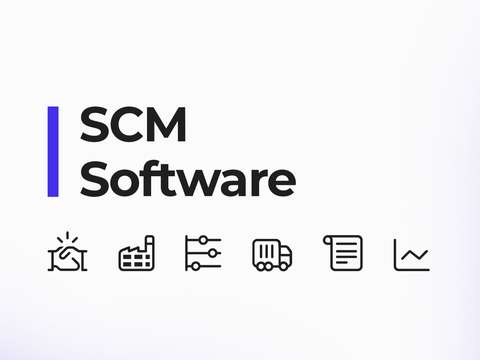Have you heard about SKU codes? If you have recently started your journey into online retail you may not know exactly what SKU codes are, how you can create SKU codes, or have even seen an SKU code example.
Find out what SKU codes are, what they look like, how you generate SKU codes, and the difference between SKUs and other identification codes like UPC, EAN or IAN.
You will also learn how to use SKUs to optimize your logistics and order preparation with eCommerce fulfillment software.
SKU code meaning: what does SKU mean?
SKU codes —also known as stock keeping unit codes— are a combination of letters and numbers that are created for the identification of a specific product.
Stock keeping units work as a product identifier. They can also be used to measure and manage stock levels in the warehouse.
SKUs help manufacturers, suppliers, and other agents organize inventory and optimize & speed up a series of tasks.

Importance of SKU codes
SKU codes are important because they can help online stores:
- Minimize the number of errors generated during the picking and packing
- Speed up the picking and packing of products
- Provide a more accurate overview of the number of items in the warehouse
- Maximize warehouse resources, ensuring an optimal stock level
- Give insights about what sizes or colors are the most and least sold
- Ensure more traceability throughout the supply chain
SKU code examples
A SKU code for a black T-shirt of size S can be TSH-000-S. The same T-shirt in a different size can be TSH-000-M. If the T-shirt is white and size M, the SKU code can be TSH-FFF-M.
| Item | First Identifier (Model) | Second Identifier (Color) | Third Identifier (Size) | SKU |
|---|---|---|---|---|
| Black T-Shirt Size Small | TSH | 000 | S | TSH-000-S |
| White T-Shirt Size M | TSH | FFF | M | TSH-FFF-M |
| Red T-Shirt Size Large | TSH | FF0000 | L | TSH-FF0000-L |
How do I create a SKU code or SKU system? Best practices
Stock keeping unit codes tend to be automatically generated through an ERP system.
To generate a SKU code, you should consider different attributes such as product type, size, and color.
To create SKU codes in a sensible and sustainable way for your sales volume, consider the different attributes you want to include in your SKU (product type, color, size, etc.) and the level of specificity. The more details you include in your SKUs, the easier it will be to identify the goods.
After this has been set, you can configure your software system to take the first three letters of the product name (i.e. TSH for T-shirts), followed by the color (i.e. 000 for black) and the size. Don't include special characters, and make your SKU codes as simple and logical as possible.
If you sell different types of black T-shirts, this example will be too generic and you will need to include more details to avoid creating duplicate SKUs.
If the SKUs aren’t unique, errors and confusions can happen in the picking and packing process, causing shipping issues later on.
SKU numbers vs. UPC, EAN, IAN and other systems
SKU vs. UPC numbers
SKUs are typically used in internal processes: product production, order processing, and shipping. UPC codes (Universal Product Code) are standardized and used both inside and outside the company’s facilities.
UPC codes are purely numerical (12 digits), while SKU numbers may include letters as well as numbers.
| SKU | UPC |
|---|---|
| Alphanumerical | Numerical |
| 8-12 characters | 12 digits |
| No barcode | Include barcode |
| Non standardized | Standardized |
SKU vs. EAN numbers
SKUs are used in internal processes, while EANs (European Article Number) are standardized and used both inside and outside the company’s facilities. While SKU and EAN numbers have a similar function, they can look different.
EAN numbers can include barcodes, while SKU codes don’t. EAN numbers combine the country code (in the form of letters) with numbers. They are standardized at a European level.
| SKU | EAN |
|---|---|
| Alphanumerical | Alphanumerical (country code) |
| 8-12 characters | 13 characters |
| No barcode | Include barcode |
| Non standardized | Standardized |
SKU vs. IAN numbers
SKUs are used in internal processes, while IAN numbers (International Article Number) are standardized and can be used internally as well as outside the company’s facilities. While SKU and IAN numbers have a similar function, they can look different. IAN codes are made up of 13 characters that include a country code and product code. They are internationally standardized.
| SKU | IAN |
|---|---|
| Alphanumerical | Alphanumerical (country code) |
| 8-12 characters | 13 characters |
| No barcode | Include barcode |
| Non standardized | Standardized |
| Popularity among couriers | Increased customer satisfaction |
SKU codes and other systems
| SKU | UPC | EAN | IAN |
|---|---|---|---|
| Alphanumerical | Numerical | Alphanumerical (country code) | Alphanumerical (country code) |
| 8-12 characters | 12 digits | 13 characters | 13 characters |
| No barcode | Include barcode | Include barcode | Include barcode |
| Non standardized | Standardized | Standardized | Standardized |
As you can see, the main difference between SKUs and other identification systems such as UPC, EAN and IAN are: the fact that they are standarized, while SKUs aren't, and that SKUs don't include a barcode.
Implementing the use of SKU codes in your online store requires a software system to automatically create these codes, since doing it manually involves a considerable investment of time and resources.
An example of this type of software would be an ERP system that not only creates these SKU codes, but also monitors production tasks, classification, inventory management, and other tasks related to order processing such as picking and packing.
To further streamline these processes, use Outvio's pick, pack, and ship software to ensure smooth post-checkout operations. This reduces the workload in departments such as customer support and warehousing, while increasing speed and efficiency in your online store.
Optimize warehouse management with our tips on warehouse design and building a warehouse network.
What are SKUs used for in the retail or eCommerce industry?
SKUs, or stock keeping units, are essential tools in the retail and eCommerce industry for several vital functions:
- Inventory Management: SKUs help retailers accurately track the quantity of each product available in inventory. This tracking includes monitoring stock levels in warehouses, on store shelves, and in transit, which is crucial for reordering, preventing stockouts, and maintaining adequate stock levels.
- Product Identification: Each SKU is a unique identifier that typically includes important information about the product, such as brand, size, color, and style. This specificity aids retailers in distinguishing between similar products and simplifying the management of product lines.
- Sales Tracking and Analysis: SKUs make it easier to analyze sales data at a detailed level. Retailers can identify which items are selling well or poorly, assess trends, and make informed decisions about promotions, discounts, and product discontinuations based on precise sales data tied to specific SKUs.
- Order Fulfillment: In eCommerce and retail, SKUs simplify the picking, packing, and shipping processes by ensuring that the correct items are selected during order fulfillment. This helps reduce errors in shipping and improves customer satisfaction.
- Pricing: SKUs allow retailers to manage pricing at a granular level. Retailers can adjust the prices of individual SKUs based on factors like demand, inventory levels, and market conditions, enabling dynamic pricing strategies.
- Supplier and Vendor Communication: When placing orders with suppliers or communicating with vendors, SKUs provide a common language that helps avoid confusion and ensures that exact specifications are met.
- Customer Service: Customer service teams use SKUs to quickly identify products for returns, exchanges, and service issues. This speeds up the resolution process and improves the overall customer experience.
- Marketing: SKUs are useful in marketing for tracking the performance of specific products through various channels and campaigns. This data can be used to tailor marketing efforts based on product performance.
FAQ
Can two products have the same SKU number?
No, SKU codes are unique identifiers for a product. This means that, if there is any difference between two products (size, color or model), they will have different SKU numbers.
What is a SKU number?
A SKU number is a unique code that helps businesses track inventory internally. SKU numbers are 100% dependant on the retailer, but there are some common practices to follow, such as lenght, characters to use, and so on.
Are SKUs and barcodes the same?
No, barcodes are for external use while stock keeping units or SKUs are for internal use. SKU numbers are chosen by the business, while barcodes should be assigned from an external source, following certain criteria.
How to calculate SKU productivity?
Divide the total sales or revenue of the SKU by the total investment or inventory cost of the SKU.
Where is the SKU number located?
The SKU number is typically located on the product's packaging, in the product description online, or on the inventory management interface.
How to create seller SKU on Amazon?
On Amazon, create a seller SKU by going to the inventory section of your seller account, adding a product, and assigning a unique SKU number to it.
What color is the SKU?
SKU, or Stock Keeping Unit, is a unique code for identifying a product and doesn't have a color. It's alphanumeric.
How to print SKU labels?
Use inventory management software or label printing software to design and print SKU labels. Ensure the printer is compatible with label sheets or rolls.
Conclusions
Now that you know what SKU codes are, what they are used for, how to generate them automatically, and the advantages that come with using SKUs, you have likely decided whether or not a SKU system makes sense for your business or if it’s better to stick to UPCs, EANs, or IANs.




